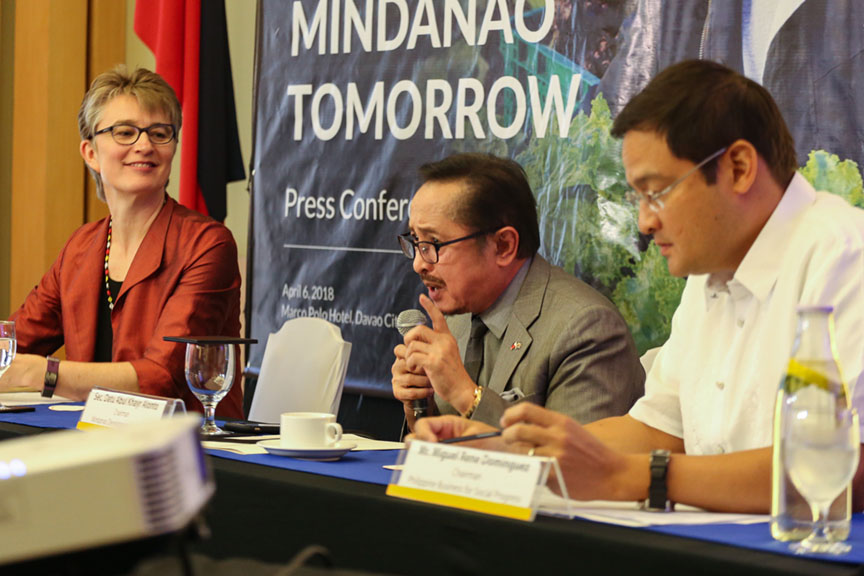DAVAO CITY (MindaNews / 6 Apr) – The proposed 2019 budget for Mindanao may increase to 24 percent from the average annual share of 11.45 percent over the past few years, Mindanao Development Authority (MinDA) chair Abul Khayr Alonto said.
 Secretary Abul Khayr Alonto (center), Mindanao Development Authority chair, at the forum on “Mindanao Today, Mindanao Tomorrow” at Marco Polo Davao. With him are Mara Warwick (left), World Bank’s Country Director for Brunei, Malaysia, the Philippines and Thailand, and Miguel Rene Dominguez, Philippine Business for Social Progress chair. MindaNews photo by MANMAN DEJETO
Secretary Abul Khayr Alonto (center), Mindanao Development Authority chair, at the forum on “Mindanao Today, Mindanao Tomorrow” at Marco Polo Davao. With him are Mara Warwick (left), World Bank’s Country Director for Brunei, Malaysia, the Philippines and Thailand, and Miguel Rene Dominguez, Philippine Business for Social Progress chair. MindaNews photo by MANMAN DEJETO
Budget Secretary Benjamin Diokno, however, said that while Mindanao would get a bigger budget, it would not be 24 percent.
In an interview at the sidelines of “Mindanao Today, Mindanao Tomorrow” at the Marco Polo Davao on Friday, Alonto told reporters that some Mindanawon lawmakers informed him that the higher proposed budget of 24 percent of the national expenditure for 2019 is feasible.
He said the budget will be needed to put in place the necessary high priority projects, including, among others, airports, seaports, bridges, road projects, hospitals, schools, and other development projects to enable the Philippines to catch up with its ASEAN neighbors.
“In all those decades, the average is 9 or 11 percent of national budget national expenditure. And it is sad because if we are talking about equity, and proper management of the resource of the country and finance, 32 to 34 percent is the minimum that should go to Mindanao,” Alonto said.
But Diokno told a press conference held on the same day that a bigger budget would be set aside for Mindanao next year but it will not be 24 percent.
“I don’t think it will amount to that because we have already decided on what kind of infrastructure projects we will build,” Diokno said.
The proposed 2019 national budget is P3.7 trillion, he said. Same amount has been set aside for 2018.
“We have already increased budget of Mindanao to around 18 percent of total budget,” Diokno said.
He pointed out that Mindanao’s budget for 2018 is already three times more than what it got 10 years ago. “That’s already a big increase,” Diokno stressed.
Although Mindanao’s potential is huge, most especially in food production, its share to the economy is still very small compared to National Capital Region (NCR), Calabarzon, and Central Luzon, which accounted for two-thirds of the economy.
MinDA executive director Romeo Montenegro said the Mindanawon lawmakers threw support behind the MinDA’s proposal for additional budget of P1.35 trillion that would be spread over a four-year period.
The interagency working group, composed of the National Economic Development Authority, Department of Budget and Management, MinDA, and the House of Representative’s Mindanao Affairs Committee, was formed to work out details to “map out strategies and address bottlenecks in terms of budget allocation and utilization for Mindanao,” Alonto said.
Mindanao’s 11.45-percent share of the country’s total budget over the last decade, he pointed out, is less than Mindanao’s average contribution of 15.29 percent to the economy since 2007.
Alonto said the budget increase would focus on the prioritization of sustainable infrastructure development that encourages development of industries, small and macro enterprises (SMEs), ecotourism, and other projects that contribute more to poverty alleviation.
He said the proposed budget includes an additional P603 billion to fund the priority programs and projects under the Mindanao Development Corridors (MinDC), such as land transport connectivity, Mindanao gateways, and the Trans-Mindanao-High-Speed Railway system.
“We have all the potentials here – we are the source of food and industrial raw materials of the country. Building roads, upgrading ports and airports, and establishing economic zones are the key to unlocking Mindanao’s potentials,” Alonto said.
He proposed the construction of Tawi-Tawi Freeport and Economic Zone, Picong Freeport, airport, and industrial estate, the next segments of the Trans-Mindanao HighSpeed Railway Project, and the establishment of Agri-Economic Cooperative Zones in the Bangsamoro areas to address food security. (Antonio L. Colina IV / MindaNews)
